So before going in, I made a list of the things that needed looking after:
- Find out if Wilde was making progress
- Transfer another frame of capped brood from Twain over to boost the workforce
- See whether Twain had made any use of the deep hive body I gave them last time
- Remove any stale sugar syrup, and
- Give new sugar syrup if the girls are still eating it
Since Queen Ellie over in Twain is running such a rocking and rolling outfit, I no longer have any empty medium frames reserved to substitute for the one I planned to steal, so I had to:
- Open Wilde first
- Grab an empty frame
- Open Twain
- Take a look at the deep hive body
- Remove it and set it aside along with TWO SUPERS FULL of honey (they are located, as they should be, between the roof of the colony and the brood area)
- Perform cursory inspection of Twain while selecting frame to steal
- Remove any hitchhiking workers and avoid removing or squashing queen
- Reassemble and close Twain
- Go back to Wilde
- Remove all supers and frames above brood nest
- Inspect structure of brood nest in order to select which frame to replace with the capped brood and to generally get some idea of how things are going
- Reassemble
Seems like a lot of steps, eh? That's why I had to sit down and think a bit before going in there. As the season goes on, the hive bodies in Twain are getting heavier and heavier, and they are harder for me to move. This is actually very good news: I already have more than 100 pounds of capped honey in there, almost enough for BOTH colonies to winter on.
But heavier hive bodies mean more bees get bashed: I can't perform the gentle-slow-sliding motions while bending over as well as I could when the frames were mostly empty. I have also had to give up bringing the camera during heavy manipulations, but the truth is that the girls (in Twain at least) are just making frame after frame of capped honey, and that is kind of a "seen one, seen them all" situation. Maybe I will try to grab you a picture next time.
It's also much hotter than before, and the bees (while still quite gentle) are easier to rile even as I am having trouble moving gracefully around them. And boy oh boy are there a lot of bees!
But I bet you are wondering what I found out, right?
Well, first of all, Wilde is doing better. That perceived traffic increase was for real: Queen Liz has been laying in every cell she can, and cells that held capped brood last time now have larvae a few days old. The workers have emptied the hive top feeder for THE VERY FIRST TIME, and they have worked every last frame in the bottom hive body. Weirdness, though: they have not moved up into the two other bodies I gave them (three medium bodies is your basic generic brood nest size). So, in order to entice them upward, I put that frame of brood stolen from Twain in the middle of the second (still empty) hive body. Considering the amount of capped brood that I saw in the bottom box, Wilde is right on the brink of exploding. There were a good 6 frames with two sides of mostly capped brood. Queen Liz was running around on the frame closest to the edge, looking for some room to get to work.
If the Wilde ones get their numbers up, and the honeymaking over in Twain continues apace, we might have enough bees and food for both colonies to make it through the winter. One thing I need to watch is whether those Wilde girls will get onto making more comb: we really need that. It would not be out of the question to steal some from Twain again, but boy is that heavy work! Sugar syrup supposedly prompts the drawing of comb, and younger bees are better at it than older ones, so maybe with this youthful onslaught, my final worry will pass.
Cross your fingers for us, OK?
 Oscar Wilde was living proof that humane people need not be boring, and that wit is suitable clothing for wisdom. "The Selfish Giant" was read to me when I was little, "Lady Windermere's Fan" was on stage just yesterday, and I love them both. "The Importance of Being Earnest" and "The Ballad of Reading Gaol" are now declared required reading for this blog. Let me know if you want to borrow my copies.
Oscar Wilde was living proof that humane people need not be boring, and that wit is suitable clothing for wisdom. "The Selfish Giant" was read to me when I was little, "Lady Windermere's Fan" was on stage just yesterday, and I love them both. "The Importance of Being Earnest" and "The Ballad of Reading Gaol" are now declared required reading for this blog. Let me know if you want to borrow my copies. An obvious choice, perhaps, but Queen Elizabeth knew quite a bit about doing alot with a little, and turning a country at odds with itself into a more peaceful and prosperous place. She ruled without a consort, and did a bit of consorting on the side. They say she might have written a few plays, and she is properly credited with a fistful of poems. What other world leaders do you know who have been mooted as possible alter-egos for Shakespeare? We'll just call her "Liz."
An obvious choice, perhaps, but Queen Elizabeth knew quite a bit about doing alot with a little, and turning a country at odds with itself into a more peaceful and prosperous place. She ruled without a consort, and did a bit of consorting on the side. They say she might have written a few plays, and she is properly credited with a fistful of poems. What other world leaders do you know who have been mooted as possible alter-egos for Shakespeare? We'll just call her "Liz." A hive is probably the only colony with which Samuel Langhorne Clemens would have allowed himself to be associated. He was a hoot to know, even though he took no prisoners on issues of race, injustice, narrow mindedness, greed, and ignorance. He lost as much money as he ever made by investing in new contraptions of the modern era, and loved one woman all his life.
A hive is probably the only colony with which Samuel Langhorne Clemens would have allowed himself to be associated. He was a hoot to know, even though he took no prisoners on issues of race, injustice, narrow mindedness, greed, and ignorance. He lost as much money as he ever made by investing in new contraptions of the modern era, and loved one woman all his life. 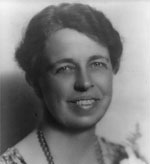 Monarchy is a poor fit for Mrs. Roosevelt, since so much of her life was about fairness, opportunity, and the individual. But it could be argued that the Queen is the hardest worker of all, both directing and creating the community around her...and she would have been used to being surrounded by males who did little enough for her. Finally, can you imagine a first lady today with a mind of her own, and the ability to lead with it? When Eleanor told the DAR that they could enter the 20th century, or linger in the 19th without her, the world moved a step forward. I hope she does not mind that we will call her namesake "Ellie."
Monarchy is a poor fit for Mrs. Roosevelt, since so much of her life was about fairness, opportunity, and the individual. But it could be argued that the Queen is the hardest worker of all, both directing and creating the community around her...and she would have been used to being surrounded by males who did little enough for her. Finally, can you imagine a first lady today with a mind of her own, and the ability to lead with it? When Eleanor told the DAR that they could enter the 20th century, or linger in the 19th without her, the world moved a step forward. I hope she does not mind that we will call her namesake "Ellie."
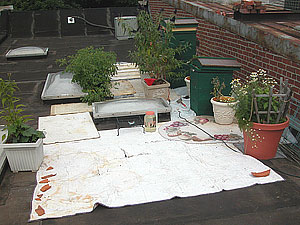 The early blast of July-ish weather finally subsided late Wednesday, giving us several heavenly days of highs in the 70s and nights in the 60s. The first of two Bee AC devices, "Bee Cool," arrived just before the temperatures broke, but after several days of nearly comic intervention on my part.
The early blast of July-ish weather finally subsided late Wednesday, giving us several heavenly days of highs in the 70s and nights in the 60s. The first of two Bee AC devices, "Bee Cool," arrived just before the temperatures broke, but after several days of nearly comic intervention on my part.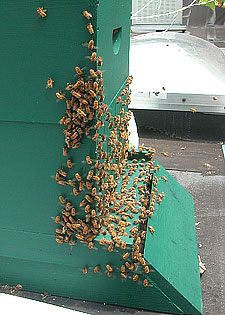 It appears that beekeepers complain alot about the weather. At least this one does. We had a long, cold, slow Spring: the stats show this, as does my pallid excuse for a garden thus far. But the past two weeks have seen the temperatures shift into high gear, 5, 10, 15 degrees above normal. Due to the cold Spring and the insistent rain the main nectar flow was short and small here, but sometimes there can be a secondary flow from Dutch clover (and we had a lot of it around the 'hood). But Dutch clover does not like scorching and dry, and guess what came right after the shrimpy main bloom?
It appears that beekeepers complain alot about the weather. At least this one does. We had a long, cold, slow Spring: the stats show this, as does my pallid excuse for a garden thus far. But the past two weeks have seen the temperatures shift into high gear, 5, 10, 15 degrees above normal. Due to the cold Spring and the insistent rain the main nectar flow was short and small here, but sometimes there can be a secondary flow from Dutch clover (and we had a lot of it around the 'hood). But Dutch clover does not like scorching and dry, and guess what came right after the shrimpy main bloom? 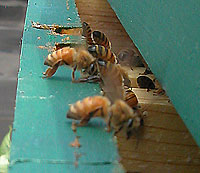 In closing, I am feeling a little bee fatigue. I think about them all the time, and after this major manipulation (well, it feels like one to me), the worrying about possible mistakes and outcomes is nagging around the edges, and I just don't need it. It will be a big relief when the Bee Cool gets here, and I know that the stress from the heat is substantially relieved. I'll keep pouring the syrup and hoping for the best, maybe with fewer heroics.
In closing, I am feeling a little bee fatigue. I think about them all the time, and after this major manipulation (well, it feels like one to me), the worrying about possible mistakes and outcomes is nagging around the edges, and I just don't need it. It will be a big relief when the Bee Cool gets here, and I know that the stress from the heat is substantially relieved. I'll keep pouring the syrup and hoping for the best, maybe with fewer heroics.
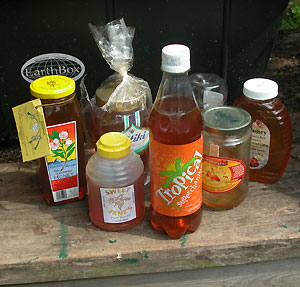 There are many symptoms of beekeeper madness, but the compulsive collection of honey is primary. Philosophical types might choose to debate this, as honey – for some – might actually be the cause, rather than the symptom.
There are many symptoms of beekeeper madness, but the compulsive collection of honey is primary. Philosophical types might choose to debate this, as honey – for some – might actually be the cause, rather than the symptom.